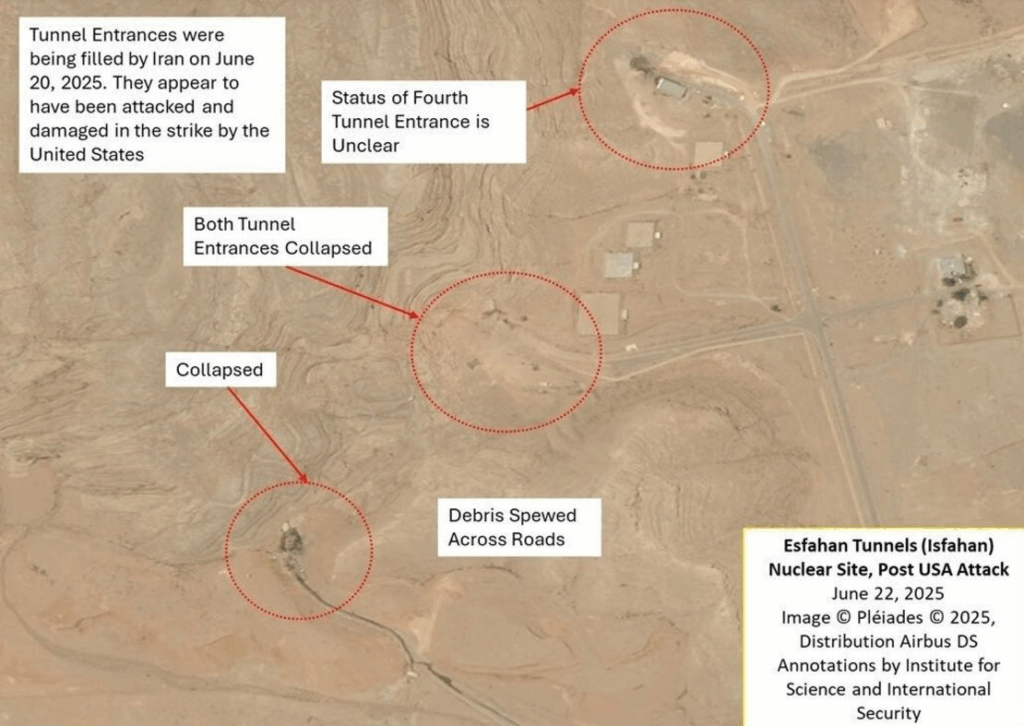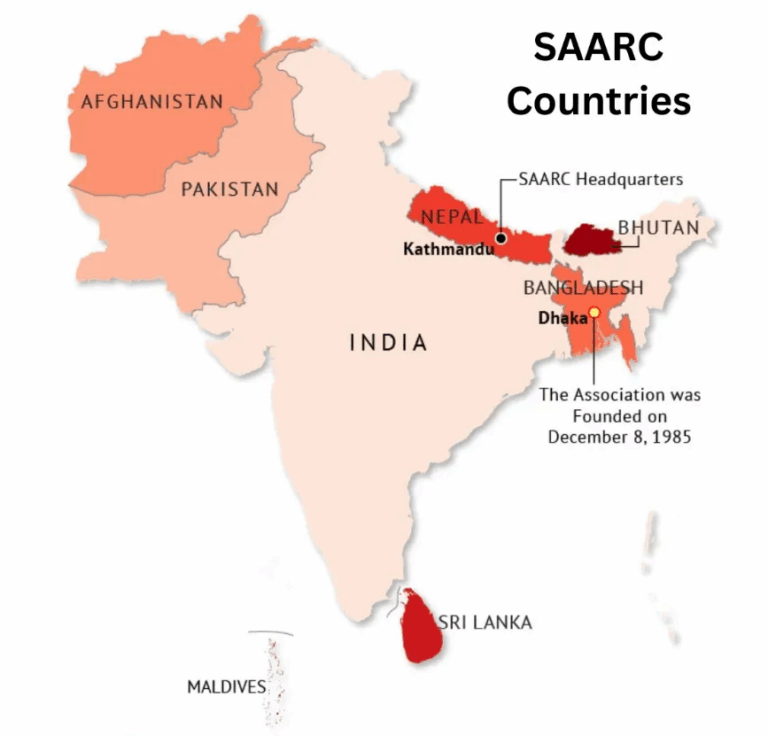U.S. Bombing of Iranian Nuclear Sites: Global Implications and Strategic Fallout
Why in the News?
In a dramatic escalation of tensions in the Middle East, the United States launched precision airstrikes on three major Iranian nuclear facilities, Fordow, Natanz, and Isfahan, using 30,000-pound bunker-busting bombs.
- President Donald Trump, bypassing Congressional approval, announced that the strikes had “completely and fully obliterated” the sites, although defence officials stated that damage assessments were still underway.
- The Iranian government confirmed the attacks and condemned them as a violation of international law and sovereignty.
- The International Atomic Energy Agency (IAEA) reported no immediate radioactive contamination but urged restraint from all sides.
- The event has ignited fears of a wider regional conflict, the breakdown of nuclear diplomacy, and a potential collapse of global non-proliferation efforts.

Background
- Iran’s nuclear programme has long been at the centre of international geopolitical tensions. The 2015 Joint Comprehensive Plan of Action (JCPOA), commonly known as the Iran nuclear deal, aimed to limit Iran’s nuclear capabilities in exchange for sanctions relief.
- However, the U.S. unilaterally withdrew from the agreement in 2018 under President Trump, leading to the unravelling of the accord and renewed uranium enrichment by Iran.
- Over the years, sites like Fordow and Natanz became symbolic of Iran’s nuclear ambitions, with Fordow being deeply buried under a mountain to resist military attacks.
- Diplomatic channels, including indirect talks via European intermediaries, had recently shown signs of progress.
- However, heightened Israeli-Iranian hostilities and accusations of Iranian support for regional militias had already pushed the situation toward volatility.
- The U.S. strikes represent a tipping point, a shift from diplomatic containment to direct military action.
Features of the U.S. Strikes and Strategic Fallout
Precision and Power
- The bombs used in the operation were GBU-57 Massive Ordnance Penetrators (MOPs), designed to penetrate hardened underground facilities.
- Targets included uranium enrichment infrastructure and underground centrifuge halls.
- The operation was conducted without U.S. boots on the ground, relying entirely on airpower and surveillance.
Trump’s Doctrinal Shift
- The strikes reflect a continuation of Trump’s assertive, unpredictable foreign policy.
- Acting without Congressional authorisation has revived debates over the War Powers Resolution and the scope of executive authority in military affairs.
- Vice-President J.D. Vance stated the attacks aimed to force Iran back to the negotiating table, though Iran flatly rejected this.
Iran’s Immediate Reaction
- Iranian Foreign Minister Abbas Araghchi denounced the attack as crossing a “big red line.”
- Iran ended its participation in all ongoing and backchannel diplomatic talks.
- Tehran announced its right to self-defence and began coordinating with allies like Russia.
Regional Security Implications
- The Gulf Cooperation Council (GCC) states expressed concern over the potential fallout, both political and environmental.
- Israel welcomed the strikes but remained cautious about Iran’s potential retaliatory attacks via Hezbollah and other proxies.
- Turkey and Russia issued strong condemnations, while China called for immediate de-escalation.
Global Diplomatic Reactions
- The European Union and United Nations urged restraint and called for the revival of the JCPOA.
- The IAEA dispatched inspectors to assess damage and radiation risks.
- Several UN Security Council members have called for an emergency session to discuss the legality and consequences of the strikes.
Media and Narrative Warfare
- Both the U.S. and Iran have launched intense media campaigns to shape international opinion.
- Iran emphasised civilian safety and sovereignty, accusing the U.S. of unilateral aggression.
- The U.S. portrayed the operation as a preventive strike against nuclear escalation.
Challenges
Risk of Escalation
- Iran could retaliate by activating its proxy networks across Iraq, Syria, Lebanon, and Yemen.
- The risk of miscalculation is high, especially with multiple state and non-state actors involved.
- A broader regional conflict could ensue, threatening oil shipping routes and global trade.
Collapse of Nuclear Diplomacy
- The JCPOA is now effectively defunct.
- Iran may accelerate nuclear enrichment activities clandestinely, pushing the region toward a nuclear arms race.
- The credibility of diplomatic mechanisms is eroded.
Violation of International Norms
- The lack of Congressional and UN approval raises concerns about the erosion of the international rules-based order.
- Unilateral military actions set dangerous precedents for other nuclear confrontations (e.g., North Korea).
Humanitarian and Environmental Concerns
- Although no radioactive leak was detected initially, long-term contamination remains a possibility.
- Retaliatory strikes in urban areas may cause civilian casualties and refugee flows.
U.S. Domestic Political Crisis
- Strong opposition from Congressional Democrats and some Republicans over executive overreach.
- Legal challenges are expected regarding the violation of the War Powers Resolution.
- Public protests have erupted in several U.S. cities.
Economic Uncertainty
- Oil prices surged immediately following the strikes.
- A prolonged crisis could destabilise global financial markets, worsen inflation, and affect food supply chains.
Way Forward
Reviving Multilateral Diplomacy
- The UN Security Council must play a central role in de-escalation.
- Neutral mediators such as Switzerland, Oman, and India could facilitate renewed dialogue.
- Diplomatic channels must reopen with a broader security framework, including missile development and regional proxy activities.
Legal and Institutional Reforms
- The U.S. Congress should reassess and clarify the War Powers Act to prevent future unilateral actions.
- International legal bodies must evaluate the legality of such pre-emptive strikes.
- Strengthening multilateral arms control institutions is essential.
Rebuilding the JCPOA or a New Framework
- While the original JCPOA may be unviable, a new agreement could address contemporary security concerns.
- A phased sanctions-lifting mechanism tied to verifiable actions should be considered.
- Incentivising Iran’s economic integration may promote compliance.
Engaging Civil Society and Track II Diplomacy
- Cultural and academic exchanges can sustain people-to-people contacts even amid official hostilities.
- NGOs and think tanks should be supported to maintain informal communication lines.
Strengthening the IAEA’s Role
- The IAEA must be empowered with enhanced inspection capabilities.
- Full transparency in reporting and public communication will help counter misinformation.
Stabilising Regional Dynamics
- A regional security dialogue platform involving Iran, Saudi Arabia, UAE, Iraq, and Turkey must be institutionalised.
- Confidence-building measures, including hotlines and military transparency, can reduce miscalculations.
Avoiding Environmental Catastrophe
- Emergency environmental assessment teams should be deployed to the bombed sites.
- Global frameworks for nuclear site protection during conflicts must be developed.
FAQ: U.S. Airstrikes on Iranian Nuclear Sites
1. What triggered the U.S. bombing of Iranian nuclear sites?
The U.S. carried out precision airstrikes on three major Iranian nuclear facilities—Fordow, Natanz, and Isfahan—using bunker-busting bombs. The strikes were ordered by President Donald Trump without Congressional approval, framed as a preemptive measure to halt Iran’s advancing nuclear program.
2. Which nuclear sites were targeted and with what weapons?
- Fordow Fuel Enrichment Plant (deeply buried under a mountain)
- Natanz Uranium Enrichment Facility
- Isfahan Nuclear Technology Center
The U.S. used GBU-57 Massive Ordnance Penetrators (MOPs), 30,000-pound bombs designed to penetrate fortified underground bunkers.
3. Was the strike authorised by international or domestic law?
No. The strike bypassed both:
- U.S. Congressional approval, raising concerns under the War Powers Resolution
- United Nations authorisation, raising questions about violations of international law and sovereignty
4. How did Iran respond?
Iran condemned the attack, withdrew from all diplomatic talks (including backchannel negotiations), and asserted its right to self-defence. It also began consultations with allies like Russia and elevated regional military alert levels.
5. What is the global diplomatic response?
- Israel supported the U.S. action cautiously.
- Russia, China, and Turkey condemned the strikes.
- The EU and UN called for restraint and urged a revival of diplomacy.
- The IAEA reported no radiation leak but demanded inspections and dialogue.
Conclusion
The U.S. bombing of Iranian nuclear sites represents a watershed moment in the geopolitical landscape of the Middle East and the future of nuclear diplomacy. While it may have temporarily halted Iran’s nuclear ambitions, it risks setting off a cascade of unintended consequences from military escalation to diplomatic collapse and legal crisis. Moving forward, diplomacy must reclaim its primacy over force.
MAINS PRACTICE QUESTION
Question: What are the global strategic, legal, and diplomatic implications of the U.S. bombing of Iranian nuclear sites, and what steps can the international community take to prevent a wider conflict and revive nuclear diplomacy?
PRELIMS PRACTICE QUESTION
Q. About the recent U.S. airstrikes on Iranian nuclear facilities, consider the following statements:
- The strikes were authorised by the United Nations Security Council under Chapter VII of the UN Charter.
- The GBU-57 Massive Ordnance Penetrator used in the strikes is specifically designed to destroy deeply buried nuclear infrastructure.
- Iran has permanently exited the Nuclear Non-Proliferation Treaty (NPT) in response to the U.S. action.
- The War Powers Resolution in the U.S. Constitution explicitly allows the President to launch preemptive strikes without Congressional approval.
Which of the statements given above is/are correct?







